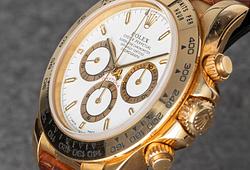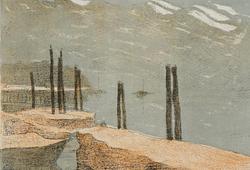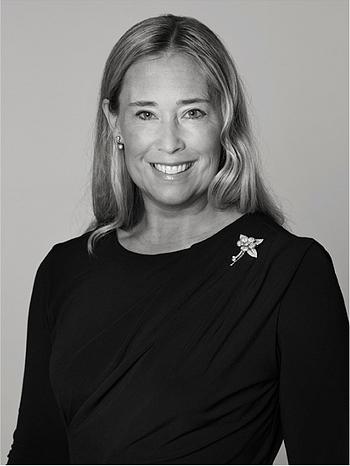Ruyistav, jade. Qingdynastin, 1800-tal.
Spiran är naturalistiskt skulpterad som en stor gren av lingzhisvamp, där den största bildar huvuddelen av spiran, längst staven mängder av lingshi i relief. Stenen har en ljus celadon nyans med fitare inslag. Längd 38 cm. Den vilar på ett sidenklätt ställ, ställets längd 39 cm.
Naturliga inneslutningar och schatteringar i stenen.
Proveniens
Gustaf Wallenberg (1863-1939) was Swedish businessman, diplomat and active politician. He was the son of André Oscar Wallenberg, founder of Stockholm Enskilda Bank (today SEB, and grandfather of Raoul Wallenberg (1912-47?). After a career in the Swedish Navy he turned to the business world and was very active in striving to better the transoceanic shipping industry. Something that came in handy when he in 1908 successfully negotiated with the Qing court in Beijing about a friendship, trade and navigation treaty. The collection was acquired between 1906 and 1918 when Wallenberg was the Swedish Envoy in Tokyo. From 1907 he was also accredited for Beijing and came to spend time in both countries as the Swedish Ambassador. Mr Wallenberg came to be in China in dramatic part of its history, when a lot of items came on the market and when the golden era of collecting Chinese works of art started in Europe.
It is visible in the communication that is kept at the Östasiatiska Museum in Stockholm that Gustaf Wallenberg and his good connections with the government came to mean a lot for all the Swedish engineers and businessmen who were in China at the time such as Johan Gunnar Andersson, Osvald Siren, Orvar Karlbeck, Erik Nordström and many more.
Bukowskis sold a part of this collection at Bukowskis Sale 554 in 2009 and Bukowskis Sale 556, 2010 as well as Bukowskis Sale 641, in 2022. These lots have remained with the family and are now offered at auction for the first time.
Utställningar
Compare with lot 2926, sold at Christies, Live Auction 14710. Important Chinese Ceramics and Works of Art, Hong Kong.
Litteratur
This ruyi sceptre is abundant with auspicious connotations by means of puns and rebuses. Ruyi means 'as you wish', and therefore the presentation of a ruyi sceptre would have been deemed as bestowing good luck.
The Yongzheng Emperor revived the tradition of presentation of ruyi sceptres by commissioning examples in various prized materials including jade, jadeite, turquoise, zitan, and filigree work. The importance of the ruyi sceptre was further reinforced by the Qianlong Emperor, who officially called upon courtiers to present ruyi sceptres at Imperial birthdays and New Year celebrations. The superb quality of the present jade sceptre would have made it suitable as such a gift.
The exceptional quality, design and skilful carving of the present lot can be compared to a number of pale green jade examples of larger size, in the Qing Court Collection, illustrated in Compendium of Collections in the Palace Museum: Jade 8 Qing Dynasty, Beijing, 2011, pls.60 and 62.
Compare also with the collection of ruyi sceptres in the Palace Collection in Taipei, depicted on their website.





































































